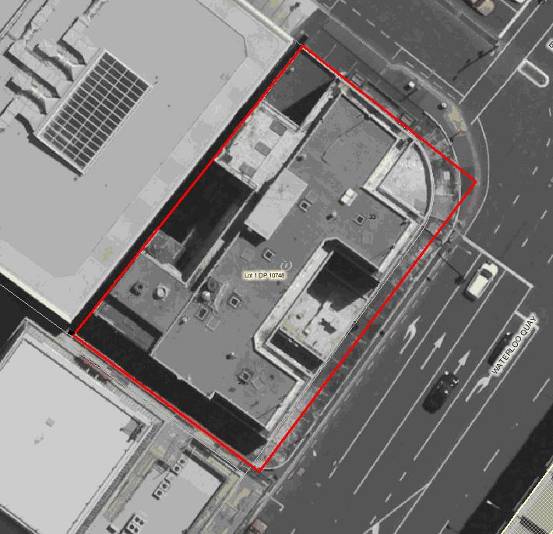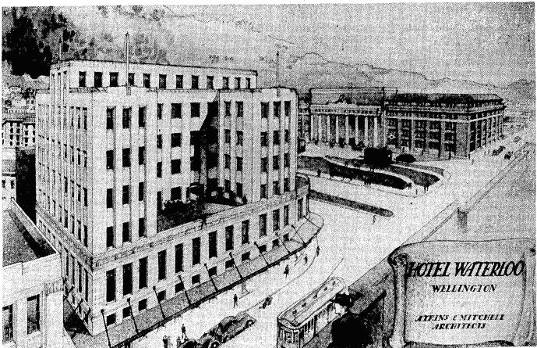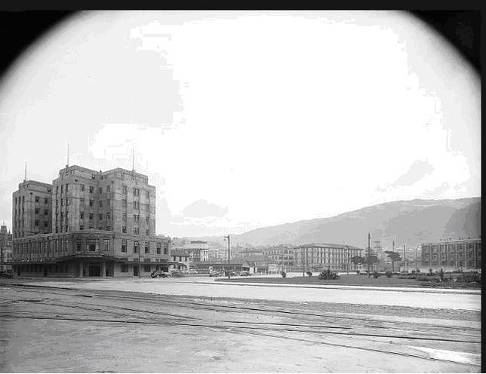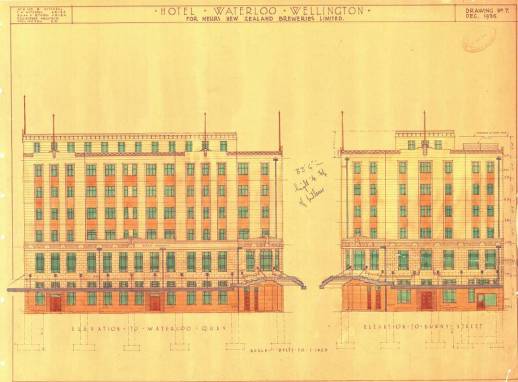Hotel Waterloo

Image: WCC - Charles Collins, 2015




Original elevations (Atkins and Mitchell, “Hotel Waterloo Wellington”, December 1935, WCC Archives reference 00056-171-B15112)
-
Constructed
1936 - 1937
-
-
Architect(s)
-
Builder(s)
Mitchell and King
-
Hotel Waterloo is one of Wellington’s best art deco buildings, and possibly the first podium and tower structure in Wellington.
The first and longest lessee was New Zealand Breweries, who commissioned the construction to coincide with the new Wellington Railway Station.
Since opening in 1937, the hotel has played a part in locals’ and visitors’ social lives. It’s still a hotel.
-
Downloadable(s)
-
close
History
-
Built in 1937, the Hotel Waterloo was celebrated as one of the finest hotels in the city at the height of its popularity in the 1940s and 1950s. It is one of the first, if not the first, examples of a podium and tower structure built in Wellington.
The land occupied by Hotel Waterloo was originally reclaimed by the Government between 1876 and 1878. The land remained largely unused for some time and even by the early 1890s there was only one substantial building on the entire block – Cable and Co.’s Lion Foundry (roughly where the Post Office headquarters building is today). The Wellington Railway Station was briefly on the corner of of Featherston and Whitmore Streets before being moved north and in 1903 the former Railways Department head office was built on this site. Smaller one and two storey railway buildings (including the NZR Signal and Electrical Branch) were also constructed. From 1893, the railway lines for the Te Aro branch ran through the middle of the block, but these were removed in 1917. The next building constructed was the Hotel Waterloo.
The hotel was built on the corner of Waterloo Quay and Bunny Street, on land subdivided from the rest of the Railways’ land in the block but which remained leasehold only. The first and longest standing lessee of the land was New Zealand Breweries, which commissioned the construction of the new hotel to coincide with the completion of the new Wellington Railway Station (1937). The proximity of several of the port’s passenger wharfs was also an attraction.
The six storey building was designed by the architect Cyril Mitchell of Atkins and Mitchell. The tender for construction was won by Mitchell and King, and the contract price was reported to be in the vicinity of £75,000. Construction of the hotel began in 1936 and the building was opened on 11 October 1937.
The occasion also marked the closing of the Central Hotel on the corner of Hunter Street and Lambton Quay, which was demolished for construction of the MLC building. The Central Hotel’s licence was formally transferred to the Waterloo Hotel after an inspection of the latter by the Wellington Licensing Committee, whose chairman S.D. Mosley stated that “we are thoroughly satisfied with the accommodation afforded for guests and employees…The waiting rooms and lounges are excellent”.
When completed, the hotel overwhelmed the immediate area. It had 102 rooms and accommodation for 125 and it was regarded as the zenith in hotel design. A contemporary account considered that it set "new standards in furnishings and interior decoration as well as in other appointments". The liberal use of chrome in many of the building's fittings was an integral part of the hotel's modern appearance. While the building was still being erected, plans were drawn up by Atkins and Mitchell to lengthen the Waterloo Quay elevation to provide more staff accommodation.
Alterations have been a regular feature of the Waterloo's history, particularly in the interior. In 1960, substantial alterations were made to the ground floor entrances, bars, dining rooms and kitchen. The following year the first floor amenities were similarly refitted. The architects on both occasions were Mitchell and Mitchell. Seven years later the public bar and private bars were much altered, the latter two being transformed into one large bar. In 1970 the hotel dining room was again altered and two years later the ground floor facades and entrance were remodelled again at a cost of $19,000. On both occasions the designs were undertaken by New Zealand Breweries' company architect D.C. Gunter, the long relationship with Mitchell and Mitchell having ended.
The hotel went into decline in the 1980s and finally closed towards the end of the decade. In 1991 the hotel was granted a new lease of life when it was converted to a backpacker’s hostel and the bars were reopened to the public. It retains those uses, although the building is dwarfed by high rise commercial and retail buildings on both the Waterloo Quay and Bunny Street sides.
-
Modifications
close
-
1936 - 1936
-
Building construction (00056:171:B15112)
-
1960 - 1960
-
Alterations to the ground floor entrances, bars, dining rooms and kitchen.
-
1961 - 1961
-
First floor re-fit.
-
1968 - 1968
-
Public bar and private bars conversion to a single bar
-
1969 - 1969
-
Building additions - lift room (00058:649:C29995)
-
1970 - 1970
-
Hotel dining room was altered
-
1972 - 1972
-
Hotel alterations (00058:785:C35318); Ground floor facades and entrance were remodelled. Building alterations-offices (00058:800:C35980); Teak room (00058:801:C35981)
-
1978 - 1978
-
Alterations-kitchen, dining room and bar (00058:1154:C49726)
-
1980 - 1980
-
Alterations- hotel foyer, ground floor (00058:1305:C55122); Alteration to hotel laundry (00058:1306:C55195)
-
1991 - 1991
-
Addition-sign (00040:8:E682183)
-
1995 - 1995
-
Alterations-ground floor, bar (00061:89:12830)
-
1996 - 1996
-
Addition-sign (00061:212:16738)
-
2002 - 2002
-
Alterations-kitchen (00078:1345:86526)
-
2003 - 2003
-
Alterations/additions-Stadium bar, backflow prevention device (00078:1045:101373)
-
2005 - 2005
-
Exemption-temporary use of a portion of an existing vacant building for one night for a function venue (standing), includes temporary egress routes, alarm system, lighting and other minor associated works-Shed 29 (g & a building kings wharf) (00078:1847:130054)
-
2006 - 2006
-
Restaurant alterations and additions (00078:1878:139785)
-
-
Occupation History
close
Not assessed
-
-
close
Architectural Information
-
Building Classification(s)
close
Not assessed
-
Architecture
close
The Hotel Waterloo occupies a prominent site on the corner of Waterloo Quay and Bunny Street where it acts as a landmark on a main arterial route into the city.
The building is an early, if not the first, example in Wellington of a podium-and-tower structure, a form that did not start becoming popular until the 1960s. The towers have been designed in a faceted arrangement, this form allows generous sunlight and views to the bedrooms in the towers. The podium has a strong horizontal emphasis with a long band of geometric patterning at parapet level, while the towers have a strong vertical emphasis. Each tower is topped with a flagpole. The four storey towers have vertically grouped windows and the spandrel towers are recessed, giving a vertical effect that accentuates their height. The recessed seventh floor has another geometric band at parapet level. The prominence of the corner entrance is extenuated by the stepped verandah, another Art Deco flourish. Inside, the main stairway is centrally located with an alternative egress stair. Both stairs are simply designed with plain painted plaster walls and solid balustrading with timber handrails.
The hotel is one of the few tall buildings in Wellington designed in the Art Deco style. It has had few exterior alterations, and some interior features remain.
-
Materials
close
Foundations are reinforced concrete. Walls are concrete and brick, rendered on the exterior.
-
Setting
close
Situated on a significant corner, this building is a landmark despite the close attentions of larger, modern neighbours. Its style, massing and colour easily distinguish it from those adjacent buildings, and the broad streets and open vistas allow it to be seen from some distance. With the Wellington Railway Station and Shed 21, it forms a small precinct of heritage buildings on the Waterloo Quay/Bunny Street intersection. The hotel still maintains its historical and physical connections with rail and sea.
-
Building Classification(s)
close
-
close
Cultural Value
The Hotel Waterloo is architecturally significant as one of Wellington’s best Art Deco buildings and its podium and tower arrangement was probably the first example of its use in the city.
The building has historic importance for its links with the Wellington Railway Station; the hotel was planned to take advantage of the opportunities offered by the construction of the new station at Bunny Street.
Since it opening in 1937, the hotel has played a significant role in the social life of Wellingtonians and visitors.
The hotel occupies a key corner site and has landmark qualities for its role in the streetscape. It is also part of precinct of significant heritage buildings on the intersection of Waterloo Quay and Bunny Street, including the Wellington Railway Station and Shed 21.
-
Aesthetic Value
close
-
Architectural
Does the item have architectural or artistic value for characteristics that may include its design, style, era, form, scale, materials, colour, texture, patina of age, quality of space, craftsmanship, smells, and sounds?
This building is one of the best of Wellington’s best Art Deco buildings; it is also one of the tallest. It’s decorative detailing and the earliest examples, if not the first example, of the podium and tower design in Wellington. It is also one of few high rise art deco buildings in Wellington.
-
Group
Is the item part of a group of buildings, structures, or sites that taken together have coherence because of their age, history, style, scale, materials, or use?
With the Wellington Railway Station and Shed 21, the hotel forms a small but significant precinct of heritage buildings around the Waterloo Quay/Bunny Street intersection.
-
Townscape
Does the item have townscape value for the part it plays in defining a space or street; providing visual interest; its role as a landmark; or the contribution it makes to the character and sense of place of Wellington?
The building is a landmark on a main arterial route into the city, and its exterior authenticity contributes a significant amount of character to the townscape. It forms the edge to a corner site and relates visually to the major open space in front of the Railway station and the waterfront.
-
-
Historic Value
close
-
Association
Is the item associated with an important person, group, or organisation?
The role of New Zealand Breweries, which leased the land, built the hotel and owned it for a number of decades, is considerable. The building is also associated with the well known architectural firm of Atkins and Mitchell, more specifically with architect Cyril Mitchell.
-
-
Scientific Value
close
-
Archaeological
Does the item have archaeological value for its ability to provide scientific information about past human activity?
This building is situated on pre-1900 reclaimed land and may have some potential archaeological value.
-
Technological
Does the item have technological value for its innovative or important construction methods or use of materials?
As one of few podium and tower designs in Wellington, it has some technical and design significance.
-
- Social Value close
-
Level of Cultural Heritage Significance
close
-
Authentic
Does the item have authenticity or integrity because it retains significant fabric from the time of its construction or from later periods when important additions or modifications were carried out?
This building has significant authenticity, with few modifications having been made to the exterior of the building.
-
Rare
Is the item rare, unique, unusual, seminal, influential, or outstanding?
As one of the first (perhaps the first) buildings of the podium and tower style in Wellington, the Hotel Waterloo has rarity.
-
Representative
Is the item a good example of the class it represents?
The Hotel Waterloo is a well designed representative of Art Deco architecture. It is also a good example of a multi-storeyed building of this design.
-
Importance
Is the item important for any of the above characteristics at a local, regional, national, or international level?
This building is important at a local, regional, and possibly national level as it is one of the first examples of the tower and podium style, as well as one of few multi-storeyed Art Deco buildings in Wellington.
-
-
Local / Regional / National / International Importance
close
Not assessed
-
Aesthetic Value
close
-
close
Site Detail
-
District Plan Number
17/338 (North and East facades)
-
Legal Description
Lot 1 DP 10748
-
Heritage New Zealand Listed
2/ Heritage Place 3610
-
Archaeological Site
Pre 1900 Reclaimed Land
-
Current Uses
unknown
-
Former Uses
unknown
-
Has building been funded
No
-
Funding Amount
Not applicable
-
Earthquake Prone Status
Not Earthquake Prone
-
-
close
Additional Information
-
External Website
-
Sources
close
- Atkins and Mitchell. “Hotel Waterloo Wellington”. December 1935. 00056-171-B15112, Wellington City Archives.
- Collins, Andrew. Inside Student Blogs, accessed 2 October 2012.
- Kernohan, David. Wellington’s Old Buildings. Wellington: Victoria University Press, 1994.
- Raine, William Hall. “View of Waterloo Hotel, ca 1930s”, ref: 1/1-018076-G, Photographic Archive, Alexander Turnbull Library, accessed 2 October 2012
- Wellington City Council. Wellington Heritage Building Inventory 2001: Non-Residential Buildings. Wellington City Council, 2001.
- Historic Places Trust. “Atkins and Mitchell-Architectural Partnership”. Professional Biographies. Accessed 2 October 2012.
- Historic Places Trust. Mitchell & Mitchell”. in Professional Biographies. Accessed 2 October 2012.
- “ONLY A MEMORY-Central’s Licence Transfer to Waterloo”, Evening Post, Volume CXXIV, Issue 88, 11 October 1937, Page 10, accessed 2 October 2012.
- Newspapers: “WATERLOO QUAY AS IT WILL BE-An Architects drawing of the Eastern aspect of the Waterloo Hotel”, Evening Post, Volume CXXI, Issue 68, 20 March 1936, Page 10, accessed 2 October 2012
- Newspapers: “HOTEL TO COST £75000”, Auckland Star, Volume LXVII, Issue 50, 28 February 1936, Page 8, accessed 2 October 2012.
- Technical Documentation close
-
Footnotes
close
Not available
-
Last updated: 7/4/2017 3:29:10 AM
